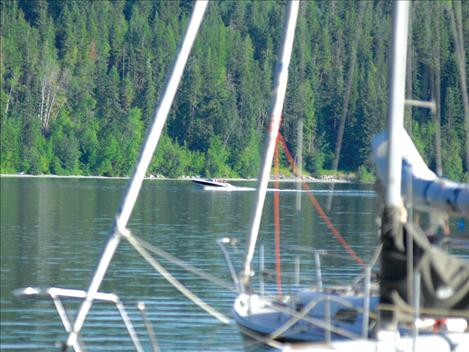Flathead Lakers meet at Yellow Bay
Hey savvy news reader! Thanks for choosing local.
You are now reading
1 of 3 free articles.
YELLOW BAY — Gael Bissell, Montana Fish, Wildlife and Parks biologist, presented the keynote address at the Flathead Lakers’ annual meeting July 26 at the Flathead Lake Biological Station at Yellow Bay.
Describing Flathead Lake as “a worldwide treasure,” Bissell talked about the 50 or 60 miles the Flathead River travels between Glacier National Park and Flathead Lake. The river meanders, providing the right substrate for cottonwoods, which creates habitat for birds and fish, riparian wetlands and cleans the water “of the stuff we put into it,” Bissell explained.
Beginning with the Critical Lands Project in 2000 and extending to the River to Lake Initiative, both collaborative efforts among many partners including the Flathead Lakers, Fish, Wildlife and Parks, and using money from federal wetland grants, 5,000 acres have been conserved and 1,600 acres of wetland and 3.5 miles of river bank restored. Education continues with Living by Water workshops to educate landowners. The project is ongoing with the third phase from 2010-13.
The annual Flathead Lakers Stewardship award was presented to Montana Fish, Wildlife and Parks, a key partner in helping protect wetlands.
Flathead Lake Biological Station Director Dr. Jack Stanford presented the annual State of the Lake report, providing a snapshot of Flathead Lake based on the monitoring data gathered by the Biological Station since the 1970s.
Showing a slide of his 30-year-old son as a child playing in an algae bloom in Flathead Lake, Stanford said, “We are trying to keep things well enough to keep this (algae bloom) from happening.”
“If you add nutrients to it, Flathead Lake will go green,” he said, adding that keeping the aquifer and riparian areas intact will keep this from happening.
“The take-home message,” he said, “is that total phosphorous is going down.”
Nitrogen is going up, too, but that’s nothing new, according to Stanford, who said it’s going up everywhere on the planet.
In response to an audience member’s question, Stanford said nitrogen comes from sewage treatment plants, burning wood, dust, street, road and farm runoff.
As far as the algae ring around the lake, since Kerr Dam was built, the algae has gotten more noticeable. This year’s level is 2.2 percent, down from 2010’s 3.1 percent.
Stanford mentioned the two monitoring buoys that measure wind, waves, light, precipitation, temperature, dissolved oxygen, chlorophyll, pH-specific conductance and water clarity six times per day. The information is filtered by the Woods Bay station and helps predict the weather, as well as many other functions.
Flathead Lake is warmer, even in the winter there is not much ice. In the ‘80s, Yellow Bay froze several times but there hasn’t been much ice during the last 10 years.
“We’re warming,” Stanford said. “Flathead Lake is just like a canary in a cave. It’s like all the big lakes; every one is warming at about the same rate the ice is disappearing on the poles.”
Warmer water in the late summer causes the cutthroat trout to quit growing. This concerns the Confederated Salish and Kootenai Tribes and MFWP as well as Stanford’s group.
He strongly feels Bonneville Power and the Northwest Power Council should fund a simulation model using the information available from the introduction of the kokanee salmon in 1915 and 1916 and the mysis introduction from 1981-83, which resulted in the extirpation of kokanee from Flathead Lake.
Gill netting could remove tons of lake trout from Flathead Lake. How that would affect the lake could be predicted by “building a model using what we do know,” Stanford stated.
Stanford also noted that the only funding Yellow Bay Biological Station receives is from the State of Montana, a line item on the University of Montana’s budget, and any donations would be appreciated.
Contact the Lakers office at (406) 883-1346 for more information or to join the organization.
















